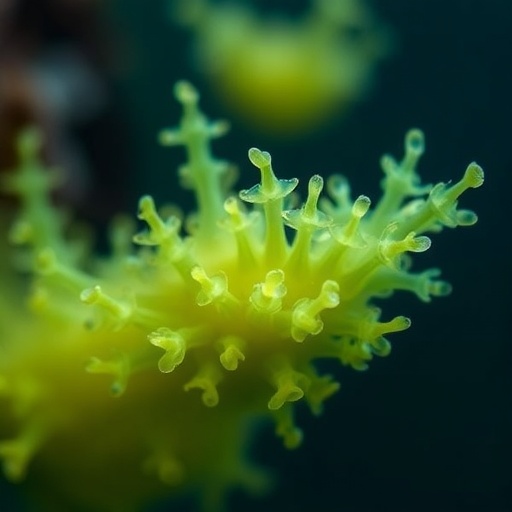In a groundbreaking study published in National Science Review, a research consortium led by Professor Dalin Shi from Xiamen University’s State Key Laboratory of Marine Environmental Science has unveiled the pivotal role of the cyanobacterium UCYN-B in marine nitrogen fixation, reshaping our understanding of nutrient cycles across the world’s oceans. Utilizing a combination of cutting-edge molecular techniques and extensive fieldwork, the team has identified UCYN-B as a dominant driver of nitrogen fixation in previously underrecognized marine hotspots, with implications that cascade through marine ecosystems and global climate dynamics.
Nitrogen fixation—the conversion of atmospheric nitrogen gas (N₂) into bioavailable forms—is a cornerstone biogeochemical process in marine environments, especially within nutrient-depleted regions where fixed nitrogen scarcity limits primary production. Diazotrophs, specialized microorganisms capable of this conversion, underpin the productivity of vast oceanic gyres. However, direct quantification of nitrogen fixation rates and community structure has historically been challenging, leading to significant gaps in our knowledge of their contributions at both regional and global scales.
The North Pacific Subtropical Gyre (NPSG), the largest continuous ecosystem on Earth, serves as a critical natural laboratory for studying oligotrophic nitrogen cycling. Previously characterized as an “ocean desert” due to its low nutrient content, the NPSG paradoxically supports substantial biological productivity largely sustained through nitrogen fixation. While earlier studies concentrated on Station ALOHA in the central gyre, this new work expands spatial coverage to the western North Pacific, revealing dramatic variability in nitrogen-fixing communities and rates unappreciated by prior assessments.
Professor Shi’s team employed large-scale, high-resolution expeditions across the western North Pacific, combining stable isotope tracing methodologies with high-throughput sequencing platforms to dissect the nitrogen-fixing community composition. Particularly noteworthy was the pervasive dominance of the unicellular cyanobacterium UCYN-B, which comprised between 67% and 99% of diazotroph populations at sites registering elevated nitrogen fixation rates, which ranged from 199 to 821 μmol N m⁻² d⁻¹ in summer months. These fixation rates rival or exceed those recorded in classical global nitrogen fixation hotspots, underscoring the ecological significance of UCYN-B in this vast oceanic domain.
Molecular quantification hinged on advanced qPCR assays targeting the nifH gene, a functional marker encoding a nitrogenase reductase essential for nitrogen fixation. This genetic approach provided fine-scale resolution of diazotrophic abundance and distribution, revealing that UCYN-B was responsible for approximately 90% of nitrogen fixation activity at high-rate localities. Complementary metagenomic analyses elucidated the genetic potential and metabolic versatility of UCYN-B populations, providing insights into their adaptative strategies in nutrient-scarce and soft environmental constraints.
Integrating global genetic datasets with environmental parameters through generalized additive models (GAMs), the researchers delineated the ecological niche of UCYN-B. The cyanobacterium flourishes in warm, oligotrophic waters characterized by low dissolved iron concentrations but relies on phosphorus availability, indicating intricate nutrient dependencies that govern its distribution. This habitat preference aligns well with environmental conditions in other (sub)tropical oligotrophic oceanic regions, including the western South Pacific, western Indian Ocean, and South Atlantic, suggesting a cosmopolitan presence hitherto underappreciated.
A striking revelation from simulation outputs is the spatial and quantitative preeminence of UCYN-B across these basin-wide environments. The study conservatively estimates that UCYN-B contributes between 5.2 and 7.2 teragrams (Tg) of fixed nitrogen annually in the western North Pacific alone. When aggregating UCYN-B-dominated regions globally, this figure escalates to roughly 10.8–15.0 Tg N yr⁻¹, constituting nearly 20% of total marine nitrogen fixation. In the Indian Ocean, UCYN-B emerges as a particularly vital player, mediating 3.4–4.8 Tg N yr⁻¹, a tenfold increase compared to previous assessments, and accounting for nearly half of the region’s nitrogen fixation.
These findings not only amend global nitrogen budgets but also bear profound implications for the ocean’s biological carbon pump. Since the onset of the Industrial Revolution, the ocean has sequestered approximately 30% of anthropogenic carbon dioxide emissions, a process intimately tied to phytoplankton productivity. The critical supply of fixed nitrogen by UCYN-B supports phytoplankton biomass and sustains primary production in oligotrophic waters, thereby influencing carbon drawdown and long-term sequestration. Yet, prior Earth system models have underestimated UCYN-B’s contributions, potentially skewing projections of oceanic carbon cycling under changing climate regimes.
By furnishing the first predictive maps detailing UCYN-B’s global distribution and quantifying its nitrogen fixation fluxes, this research significantly advances the predictive capacity of biogeochemical models. The elucidation of environmental controls such as temperature, trace metal limitation, and nutrient availability enhances mechanistic understanding, allowing for refined simulation of diazotrophic cyanobacteria dynamics in response to environmental change. This is pivotal as climate change progress threatens to remodel ocean stratification, nutrient supply, and by extension, biological nitrogen fixation patterns.
Furthermore, the study’s multi-disciplinary approach—marrying field sampling, molecular biology, and statistical modeling—embodies an exemplary framework to address the complexity of marine microbial ecology. As nitrogen fixation is a critical nexus between the ocean nitrogen and carbon cycles, insights into UCYN-B ecology and function herald improved projections of global biogeochemical fluxes, ecosystem productivity, and climate feedback mechanisms.
A broader implication concerns the recognition of UCYN-B as a keystone taxon in marine nitrogen fixation, redirecting attention from traditionally emphasized taxa such as Trichodesmium and Richelia. This paradigm shift underscores the intricacy of marine microbial communities and the necessity to reassess functional contributions of lesser-known yet ecologically consequential microorganisms.
In sum, this pioneering investigation spotlights UCYN-B’s extraordinary capacity to fix nitrogen at basin and global scales, revising existing nitrogen cycle paradigms and advancing our capacity to predict oceanic responses to anthropogenic pressures. By unraveling the nuanced interplay of environmental factors shaping UCYN-B distribution and activity, the study amplifies our grasp on ocean nutrient dynamics, marine productivity, and the broader Earth system’s resilience under a warming climate.
Subject of Research: Marine nitrogen fixation and the ecological role of cyanobacterium UCYN-B in global ocean productivity.
Article Title: Not specified within provided content.
Web References:
http://dx.doi.org/10.1093/nsr/nwaf337
References:
National Science Review, DOI: 10.1093/nsr/nwaf337
Image Credits:
©Ruotong Jiang, Haizheng Hong, and Dalin Shi
Keywords:
UCYN-B, nitrogen fixation, marine cyanobacteria, diazotrophs, oligotrophic ocean, nitrogen cycle, carbon cycle, biogeochemistry, North Pacific Subtropical Gyre, Earth system modeling, nifH gene, ocean productivity




